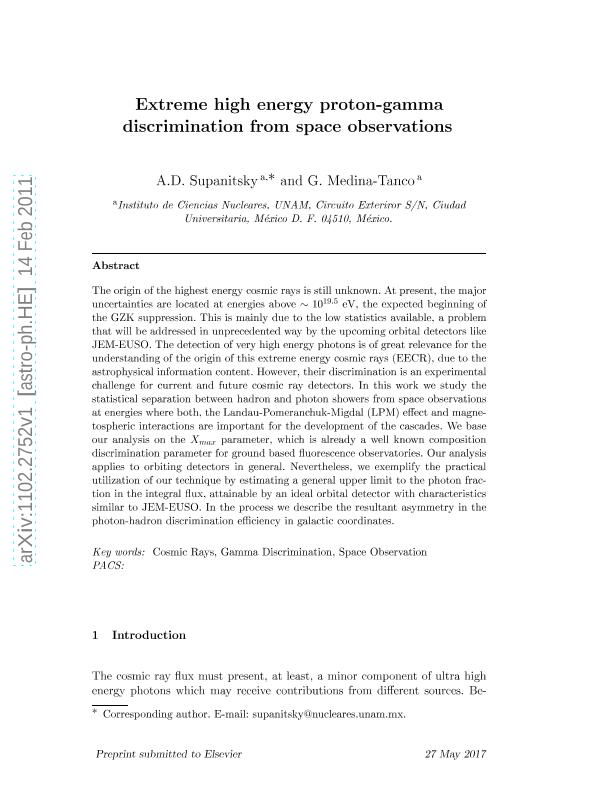Mostrar el registro sencillo del ítem
dc.contributor.author
Supanitsky, Alberto Daniel

dc.contributor.author
Medina Tanco, Gustavo Adolfo

dc.date.available
2017-07-06T20:51:06Z
dc.date.issued
2011-03
dc.identifier.citation
Supanitsky, Alberto Daniel; Medina Tanco, Gustavo Adolfo; Extreme high energy proton-gamma discrimination from space observations; Elsevier Science; Astroparticle Physics; 34; 3-2011; 789-795
dc.identifier.issn
0927-6505
dc.identifier.uri
http://hdl.handle.net/11336/19820
dc.description.abstract
The origin of the highest energy cosmic rays is still unknown. At present, the major uncertainties are located at energies above ~10^19.5 eV, the expected beginning of the GZK suppression. This is mainly due to the low statistics available, a problem that will be addressed in unprecedented way by the upcoming orbital detectors like JEM-EUSO. The detection of very high energy photons is of great relevance for the understanding of the origin of this extreme energy cosmic rays (EECR), due to the astrophysical information content. However, their discrimination is an experimental challenge for current and future cosmic ray detectors. In this work we study the statistical separation between hadron and photon showers from space observations at energies where both, the Landau–Pomeranchuk–Migdal (LPM) effect and magnetospheric interactions are important for the development of the cascades. We base our analysis on the Xmax parameter, which is already a well known composition discrimination parameter for ground based fluorescence observatories. Our analysis applies to orbiting detectors in general. Nevertheless, we exemplify the practical utilization of our technique by estimating a general upper limit to the photon fraction in the integral flux, attainable by an ideal orbital detector with characteristics similar to JEM-EUSO. In the process we describe the resultant asymmetry in the photon–hadron discrimination efficiency in galactic coordinates.
dc.format
application/pdf
dc.language.iso
eng
dc.publisher
Elsevier Science

dc.rights
info:eu-repo/semantics/openAccess
dc.rights.uri
https://creativecommons.org/licenses/by-nc-sa/2.5/ar/
dc.subject
Cosmic Rays
dc.subject
Gamma Discrimination
dc.subject
Space Observation
dc.subject.classification
Astronomía

dc.subject.classification
Ciencias Físicas

dc.subject.classification
CIENCIAS NATURALES Y EXACTAS

dc.title
Extreme high energy proton-gamma discrimination from space observations
dc.type
info:eu-repo/semantics/article
dc.type
info:ar-repo/semantics/artículo
dc.type
info:eu-repo/semantics/publishedVersion
dc.date.updated
2017-07-06T13:03:25Z
dc.journal.volume
34
dc.journal.pagination
789-795
dc.journal.pais
Países Bajos

dc.journal.ciudad
Amsterdam
dc.description.fil
Fil: Supanitsky, Alberto Daniel. Consejo Nacional de Investigaciónes Científicas y Técnicas. Oficina de Coordinación Administrativa Ciudad Universitaria. Instituto de Astronomía y Física del Espacio. - Universidad de Buenos Aires. Facultad de Ciencias Exactas y Naturales. Instituto de Astronomía y Física del Espacio; Argentina. Universidad Nacional Autónoma de México; México
dc.description.fil
Fil: Medina Tanco, Gustavo Adolfo. Universidad Nacional Autónoma de México; México
dc.journal.title
Astroparticle Physics

dc.relation.alternativeid
info:eu-repo/semantics/altIdentifier/doi/http://dx.doi.org/10.1016/j.astropartphys.2011.02.003
dc.relation.alternativeid
info:eu-repo/semantics/altIdentifier/url/https://arxiv.org/abs/1102.2752
dc.relation.alternativeid
info:eu-repo/semantics/altIdentifier/url/http://www.sciencedirect.com/science/article/pii/S0927650511000387
Archivos asociados
